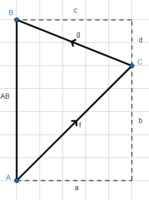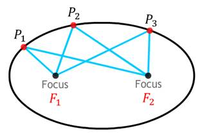a_guy_and_he_does_stuff
New member
- Joined
- Dec 13, 2019
- Messages
- 6
Hello all, first time posting here. I'm currently chipping away at a rather tricky problem about mirrors and reflections, and I need help finding something - the equation of the normal/tangent line to an ellipse.
I have an ellipse with equation [MATH]k = \sqrt{a^2 + b^2} + \sqrt{a^2 + (AB - b)^2}[/MATH], where [MATH]k[/MATH] is some real number and [MATH]AB[/MATH] is the length of the line which connects the two centers of the ellipse.
Now, what I want to do is have a generalized equation that gives the vector function of the normal or tangent line to the surface of any ellipse of that specified form (OR the direction of that given line). My first attempt consisted of making the ellipse into a function of two variables and taking its gradient hoping to find the normal line to the surface (fresh out of multi-variable, first thing I thought of), and, though it produced a very interesting pattern, did not do what I wanted it to. It produced the gradient in reference to k.
I'm unsure how to proceed. My only other thought is the implicit function theorem or the simple, calculus 1 method for differentiating implicit functions, but I'm also unsure how to apply those two to this case.
I'm very tired right now, so I'll end it here.
I have an ellipse with equation [MATH]k = \sqrt{a^2 + b^2} + \sqrt{a^2 + (AB - b)^2}[/MATH], where [MATH]k[/MATH] is some real number and [MATH]AB[/MATH] is the length of the line which connects the two centers of the ellipse.
Now, what I want to do is have a generalized equation that gives the vector function of the normal or tangent line to the surface of any ellipse of that specified form (OR the direction of that given line). My first attempt consisted of making the ellipse into a function of two variables and taking its gradient hoping to find the normal line to the surface (fresh out of multi-variable, first thing I thought of), and, though it produced a very interesting pattern, did not do what I wanted it to. It produced the gradient in reference to k.
I'm unsure how to proceed. My only other thought is the implicit function theorem or the simple, calculus 1 method for differentiating implicit functions, but I'm also unsure how to apply those two to this case.
I'm very tired right now, so I'll end it here.


